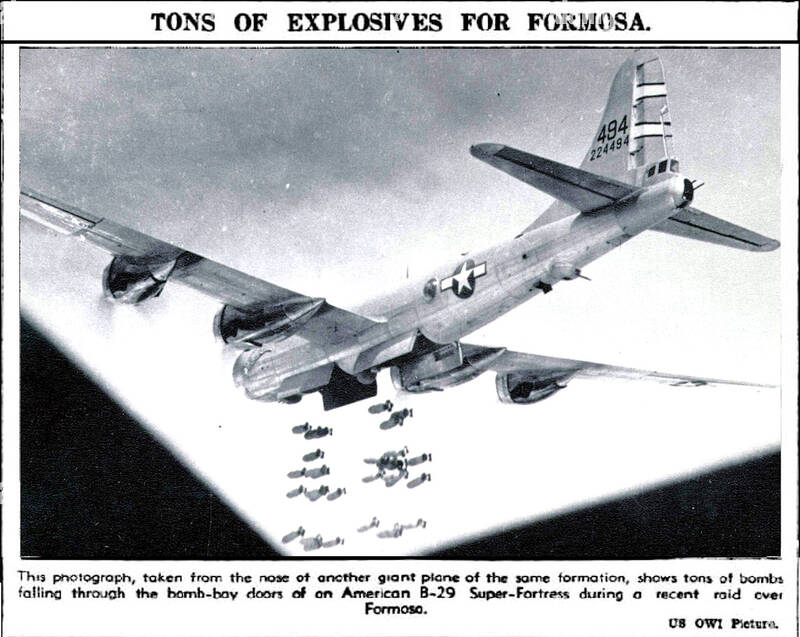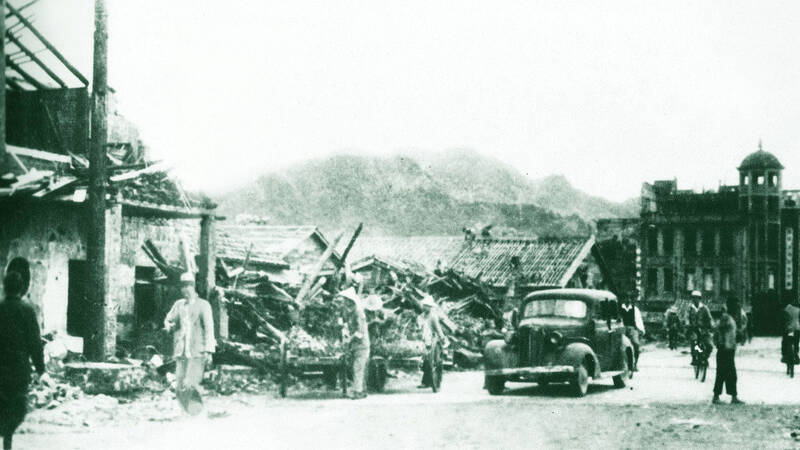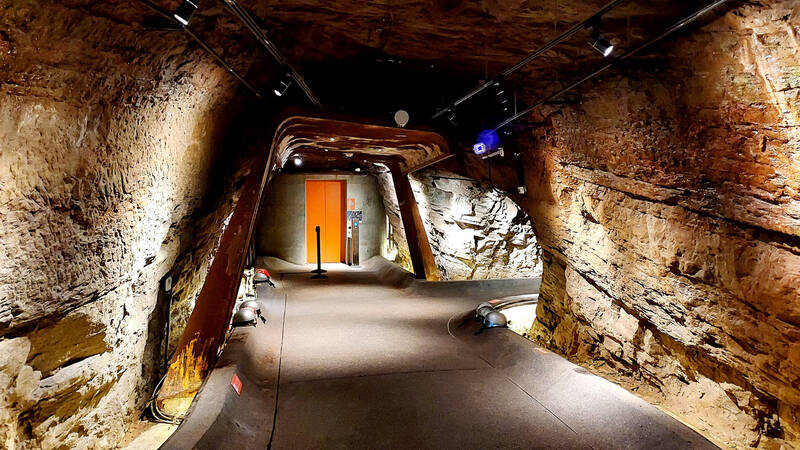June 17 to June 23
Sixty B-24 heavy bombers from the US’s Fifth Air Force appeared over the port city of Keelung on June 16, 1945, escorted by eight P-51 long-range fighters. One group unleashed a torrent of 260-pound (117kg) bombs onto the ships in the harbor, while another squadron dropped 1,000-pound (454kg) explosives onto the port facilities.
The onslaught partially destroyed two power plants for the Japanese-owned Taiwan Shipping Dock Corporation and damaged the tracks at Keelung Railway Station in five different places. The bombers returned in large numbers over the next three days, with the US “determined to eradicate the port,” writes Chang Wei-bin (張維斌) in the 2015 book Formosa Air Raid Chronology (空襲福爾摩沙).

Photo courtesy of Wikimedia Commons
As northern Taiwan’s major port and military command center, Keelung was a major target for the Allies during World War II, with the first bombs falling on Oct 12, 1944. Airstrikes continued in the ensuing months, but it was the intense bombardment from June 16 to June 19 that is known today as the “Keelung Air Raid” (基隆大空襲).
Countless other places in Taiwan were hit between October 1944 and August 1945, and at the same time as the Keelung Air Raid, the US also conducted smaller strikes all across Taiwan and Penghu. Official numbers by the Japanese colonial government show that the raids killed more than 5,500 people, injured 8,500 and affected nearly 280,000 residents.
These bombings faded into history after the war after the Japanese left, and as Taiwan became reliant on US aid and political support, but they have been revisited in recent years, especially with the 70th anniversary of the events in 2015.

Photo courtesy of Wikimedia Commons
TARGETING FORMOSA
The US Air Force laid out its plans for Taiwan in the top secret Formosa Interim Report from February 1944.
“Formosa, the southern anchor of Japan’s inner defense zone, is a multi-purpose base for military operations in the SW Pacific region and an integrated unit of the Japanese Empire’s war economy,” the report’s opening statement reads. “In the development of the island’s communications, as well as many of its economic activities, military usefulness has been the primary consideration.”

Photo courtesy of Wikimedia Commons
Taiwan’s strategic location made it a “valuable link” in funneling troops, supplies and aircraft, the report continued, and its facilities also serve as a jumping off point for various operations, late-phase training and as a replacement center for field forces.
Thus, attacks against Taiwan’s transportation, shipping and military infrastructure would “not only have some effect on the industrial potential of Japan proper, but would also be felt in Japanese military capabilities in such distant theaters such as SE Asia, the [Dutch East Indies] and in the SW Pacific Islands.”
In particular, the report notes that Formosa’s potential is “dependent on the continuous operation of sea communications, centering primarily at the ports of Takao (Kaohsiung) and Keelung.”
Keelung also served as a railway link and was home to important electrochemical plants. Badu (八堵) was also included for its bridges and tunnels connecting Keelung with Taipei, and its steam power plant.
Before the report, however, the US had already launched a surprise attack on Hsinchu’s military air base in November 1943. Setting out from China’s Jiangxi Province, the force of 29 B-25s, P-38s and P-51s destroyed numerous Japanese planes while suffering minimal damage.
INTENSIFYING RAIDS
The US conducted intermittent US strikes mostly on Kaohsiung harbor over the following year, but things heated up in October 1944 as the Allies prepared to invade Japanese-occupied Leyte Island in the Philippines. To prevent Japan from calling in reinforcements from Taiwan, the US dispatched four aircraft carrier task groups to Taiwan on the morning of Oct. 12.
Over the next two days, warplanes targeted air bases and ports across the entire island and engaged in aerial battles with Japanese forces. Now known as the Formosa Air Battle, this was the first time Keelung was bombed, although it didn’t seem to be a major target with the Kaohsiung area bearing the brunt of the assault.
The initial attack on Keelung at 6am was mostly unsuccessful due to thick clouds, but planes soon returned a few hours later, striking power plants, ships and other facilities. Inclement weather prevented any further attacks on the city for the remainder of the clash, which concluded on Oct. 17 with a massive bombardment of Kaohsiung’s harbor and Tainan’s airfield. The battle was a success for the US, with more than 300 Japanese planes lost and significant infrastructure destroyed.
Attacks on Keelung — and the rest of Taiwan — resumed in January 1945, intensifying in late May. On May 19, 98 B-24s unleashed powerful 2000-pound (907kg) bombs on the port. The next evening, four B-24s scorched the city center.
Aside from their military targets, the US began directly bombing administrative centers as the war dragged on, seriously damaging Tainan in March, followed by Chiayi, Kaohsiung and Taipei in May. The scars of these events can still be seen on buildings today.
FINAL BOMBINGS
The US followed up on their June 16 attack on Keelung the next day, this time aiming for various industrial plants and railway facilities. On the third day, they bombed port facilities as well as residential and commercial zones in the south of the city. Another 51 B-24s annihilated the remaining port functions on the final day, also burning down a fertilizer plant and timber warehouse.
With that, the months-long nightmare for Keelung’s residents came to an end. There was one final attempt to destroy the railroad bridge in Badu to cut Keelung off from Taipei on June 25, but none of the bombs hit the target.
Airstrikes continued elsewhere until the Japanese surrendered on Aug. 15. The last coordinated attacks on Aug. 12 aimed at the Taipei airfield as well as various railway facilities. Chiayi’s airfield and the nearby Shueishang (水上) township office were decimated.
The final bombs were dropped on two ships near Penghu’s Jibei Island (吉貝嶼) on Aug. 14 during a surveillance mission.
Due to Keelung being 95 percent mountainous, numerous air raid shelters were dug directly into the side of the hills. Unlike underground shelters, these tunnels were more durable and less likely to be demolished during urban development, and a high concentration of them still exist.
According to the Keelung City Cultural Affairs Bureau, a survey in 1955 found 85 usable tunnels. Several were added over the years and expanded in case of war. Some have since been converted into restaurants and other spaces.
Taiwan in Time, a column about Taiwan’s history that is published every Sunday, spotlights important or interesting events around the nation that either have anniversaries this week or are tied to current events.

This month the government ordered a one-year block of Xiaohongshu (小紅書) or Rednote, a Chinese social media platform with more than 3 million users in Taiwan. The government pointed to widespread fraud activity on the platform, along with cybersecurity failures. Officials said that they had reached out to the company and asked it to change. However, they received no response. The pro-China parties, the Chinese Nationalist Party (KMT) and Taiwan People’s Party (TPP), immediately swung into action, denouncing the ban as an attack on free speech. This “free speech” claim was then echoed by the People’s Republic of China (PRC),

Exceptions to the rule are sometimes revealing. For a brief few years, there was an emerging ideological split between the Democratic Progressive Party (DPP) and Chinese Nationalist Party (KMT) that appeared to be pushing the DPP in a direction that would be considered more liberal, and the KMT more conservative. In the previous column, “The KMT-DPP’s bureaucrat-led developmental state” (Dec. 11, page 12), we examined how Taiwan’s democratic system developed, and how both the two main parties largely accepted a similar consensus on how Taiwan should be run domestically and did not split along the left-right lines more familiar in

Specialty sandwiches loaded with the contents of an entire charcuterie board, overflowing with sauces, creams and all manner of creative add-ons, is perhaps one of the biggest global food trends of this year. From London to New York, lines form down the block for mortadella, burrata, pistachio and more stuffed between slices of fresh sourdough, rye or focaccia. To try the trend in Taipei, Munchies Mafia is for sure the spot — could this be the best sandwich in town? Carlos from Spain and Sergio from Mexico opened this spot just seven months ago. The two met working in the

Many people in Taiwan first learned about universal basic income (UBI) — the idea that the government should provide regular, no-strings-attached payments to each citizen — in 2019. While seeking the Democratic nomination for the 2020 US presidential election, Andrew Yang, a politician of Taiwanese descent, said that, if elected, he’d institute a UBI of US$1,000 per month to “get the economic boot off of people’s throats, allowing them to lift their heads up, breathe, and get excited for the future.” His campaign petered out, but the concept of UBI hasn’t gone away. Throughout the industrialized world, there are fears that